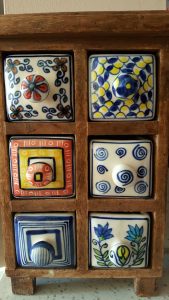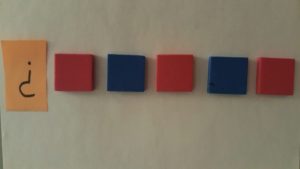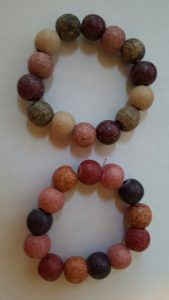Using Children’s Literature to Reinforce Patterns
posted by Dr. Jeanne White
Young children naturally begin to create patterns with objects such as Unifix cubes or colored tiles, even if they do not realize what they’ve created is called a pattern. A child’s early knowledge of color or shape patterns can lead to later recognition of more complex patterns in large numbers and within the four operations.
A book that can be used to introduce young children to patterns in the environment is the book Math Counts: Pattern (Pluckrose, 1995). The book contains photographs of patterns found in nature such as on leaves, flowers and insects. The book also shows patterns found in familiar objects such as on a car tire, the sole of a shoe and wallpaper. Encourage children to draw or photograph their own pattern discoveries such as on clothing, jewelry or furniture
 Another book that can be used to introduce patterns is Rooster’s Off to See the World (Carle, 1972). In the story, one rooster decides to travel and meets two cats, three frogs, four turtles and lastly, five fish. As he meets each set of animals, pictures of the animals are displayed in the upper corner of the right page. Children can see the growing pattern of animals from one rooster up through five fish. Eventually, all of the animals disappear, starting with the five fish. The pictures of the animals appear in the upper corner of the left page and gradually disappear until only a picture of one rooster is there. Children can see another pattern as the number of animals decreases from five down to one again.
Another book that can be used to introduce patterns is Rooster’s Off to See the World (Carle, 1972). In the story, one rooster decides to travel and meets two cats, three frogs, four turtles and lastly, five fish. As he meets each set of animals, pictures of the animals are displayed in the upper corner of the right page. Children can see the growing pattern of animals from one rooster up through five fish. Eventually, all of the animals disappear, starting with the five fish. The pictures of the animals appear in the upper corner of the left page and gradually disappear until only a picture of one rooster is there. Children can see another pattern as the number of animals decreases from five down to one again.
Set up activities following this book such as displaying familiar object to create an AB pattern (using only two different elements in the pattern) for a child to continue. Start with color patterns and say the colors aloud as you display each one, “Red, blue, red, blue.…” After several examples of color patterns, use toys and say the name of the objects as you display each one, “plate, spoon, plate, spoon….”

 Once children have practiced recognizing and repeating patterns with cubes, blocks, toys and familiar objects, they can begin to listen for patterns in songs, stories and nursery rhymes. A book that can be used as an example of a pattern set within a story structure is The Napping House (Wood, 1984). It’s a rainy day and everyone is napping in the house, including a snoring granny. But then the granny is joined by a dreaming child, followed by a dozing dog, then a snoozing cat, a slumbering mouse, and a wakeful flea. Each of these nappers pile on the bed with granny one by one, and are introduced on each page, one by one, adding to the words from the previous page: “And on that granny there is a child…and on that child there is a dog…and on that dog there is a cat….”
Once children have practiced recognizing and repeating patterns with cubes, blocks, toys and familiar objects, they can begin to listen for patterns in songs, stories and nursery rhymes. A book that can be used as an example of a pattern set within a story structure is The Napping House (Wood, 1984). It’s a rainy day and everyone is napping in the house, including a snoring granny. But then the granny is joined by a dreaming child, followed by a dozing dog, then a snoozing cat, a slumbering mouse, and a wakeful flea. Each of these nappers pile on the bed with granny one by one, and are introduced on each page, one by one, adding to the words from the previous page: “And on that granny there is a child…and on that child there is a dog…and on that dog there is a cat….”
Encourage young children to listen for patterns when you read stories or to look for patterns in photographs and illustrations in books, on posters and other media. Recognizing patterns sets the foundation for algebraic thinking—analyzing patterns, relationships and change throughout the study of mathematics.

I can\’t wait to apply this to my classroom!
There are so many books that can be used, this is a wonderful idea
I love using books with patterns! It allows the children to get involved as many of them know what will be coming next.
I love using books with patterns as well. The children are usually engaged and love predicting what is coming next. It is also a fun way of introducing patterns to young children.
Anything can be used to see patterns practically! so many books. Poems and songs. The pattern of the sun and moon. Looking forward to using this in classs!
Books are an awesome way to include pattern exercises! I hadn’t really thought about it much before this post. Thank you!
We do a ton of patterning in our classroom. The children love anything that is a pattern, and with practice, have begun to search them out all around them! Love the Napping House!!!!
Lori Fleetwood
I had not really thought of that type of reading as a lesson in patterns. I have several books already that have this type of patterning and I will be reading them a little differently from now on
My class of young 2’s loves the book Chika Chika Boom Boom because they can get involved with the reading. I was not aware it was because of a pattern. I guess I didn’t put that much thought into it because we just like having fun together and reading great books. Does any one have other suggestions of pattern books for a young two year old class.
Stories with patterns in them are always such fun read alouds and hold their attention. I just love the literature/math connection!
It’s always fun to use books with patterns. Can’t wait to try these new titles!
As an art museum educator by training, I’ d like fellow teachers to consider using works of art to identify and replicate patterns. Connecting these images to local people and places would enrich the experience.
The book I like to read is “The very busy spider” and I add motions of clap hands and then slap knees when it says “she is very busy spinning her web” and then I add “she works and works and works” after ” “she is very busy spinning her web”. The kids join in and then remember the predictability of the words and the actions.
I like the the idea for using books to look for patterns. I enjoy getting the children’s involvement and watch their understanding grow as they are learning. So many things to talk about in books.
I like the the idea for using books to look for patterns. I enjoy getting the children’s involvement and watch their understanding grow as they are learning. So many things to talk about in books.